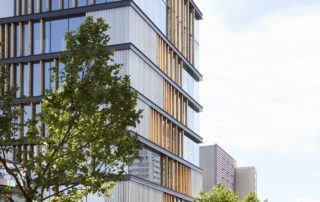Squire & Partners has completed a major commercial development at London’s King’s Cross
Designed by Squire & Partners, Rolling Stock Yard provides more than 5300-square-metres of workspace for small to medium sized creative businesses in King’s Cross, London. Capable of responding to the needs of growing companies, the building comprises an adaptable collection of working spaces with units ranging from 150 to 680-square-metres in size.
The nine-storey scheme is conceived as a contemporary response to its site, which was previously characterised by transport, freight and industry. Converging railway lines and shipping containers are expressed as a series of stacked elements with a black profiled steel structure emulating parallel railway tracks running horizontally across the facades. Within this horizontal grid, full-height glazing is softened by a layer of vertical solid oak sleepers and sinusoidal perforated metal screens. The latter provide privacy and shade during daylight hours, and emit a diffused glow at night.
Site plan; ground-floor plan; mezzanine; typical upper floor plan; section
At pavement level the building animates the street with bespoke illuminated entrance signage behind a corrugated metal screen, and a double-height office entrance addressing York Way. Internally, a pair of timber-lined recesses for the reception and cafe balances an industrial palette of exposed concrete, blackened steel and perforated aluminium. Unifying the space is a pale-grey poured resin floor with inlaid track patterns, which define routes from the entrance to the reception, lifts and cafe.
Suspended filament lighting elements hang vertically at assorted heights above a bespoke rug, which continues the graphic of converging rail tracks. Low comfortable seating on leather sofas, wing backed armchairs and upholstered benches create a comfortable waiting area for visitors.
For building users and guests, the Rolling Stock Cafe within the main entrance provides raised seating at high tables with access to power and data, as well as additional space on a mezzanine floor with more informal and lounge seating. The two levels are connected by a folding metal stair, behind which a large-scale painting, commissioned by celebrated London artist Barry Reigate, provides a playful backdrop. Combining cartoon imagery and graffiti with geometric shapes and cultural references to King’s Cross, the site- specific work projects a dynamic urban attitude.
At 12×6 metres, the installation is Reigate’s largest work to date, and was applied layer by layer over five weeks using monochromatic tones to complement the building’s industrial palette. The work is presented as an architectural element within the space, drawing on the local built environment and encouraging people to move around the space to discover different aspects of the painting.
Lift lobbies feature bespoke floor numbering graphics on the reveal and blackened steel lift doors. Wayfinding tracks within the resin floor continue into the lift car.
Office spaces benefit from natural light on three sides – all four on the upper level – and every floor has openable windows to allow for natural cross ventilation. Exposed concrete ceilings continue the industrial aesthetic, with suspended lighting tracks directing light up and down. Circulation on each level is marked with a backlit perforated metal screen, leading to the lift lobby and toilets.
A 140-square-metre private roof terrace with planters and linear floor lighting occupies the upper level, providing panoramic views across the skyline.
The toilets are conceived as ‘superloos’, comprising self-contained cubicles with black Corian worktops and splashbacks, sinks, large mirrors and vertical feature lights. The back wall of each cubicle is lined with panels of natural ply featuring an engraved pattern depicting freight containers.
Some 300-square-metres of roof space has been planted with wildflowers and grasses chosen to support local birds, bees and butterflies. Located on top of the planted bed are 120 solar panels, with a further 80 panels on the south facade.
Additional Images
Credits
Architect
Squire & Partners
Structural engineer
Davies Maguire
Services engineer
Atelier Ten
Quantity surveyor
Currie & Brown















































